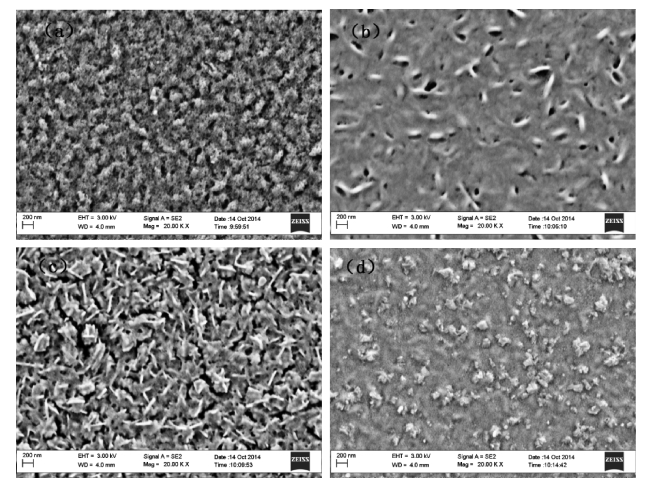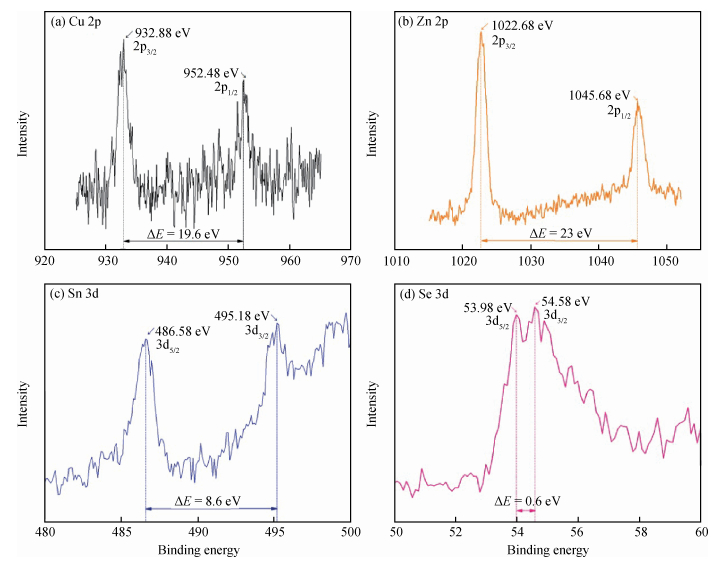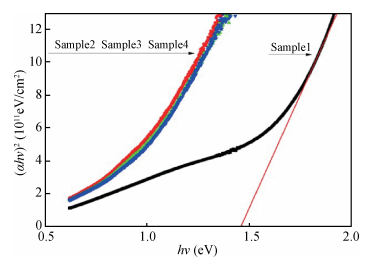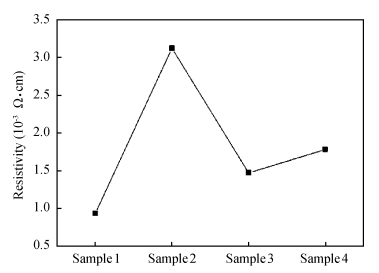| Citation: |
Jun Zhao, Guangxing Liang, Yang Zeng, Ping Fan, Juguang Hu, Jingting Luo, Dongping Zhang. The influence of sequence of precursor films on CZTSe thin films prepared by ion-beam sputtering deposition[J]. Journal of Semiconductors, 2017, 38(2): 023002. doi: 10.1088/1674-4926/38/2/023002
****
J Zhao, G X Liang, Y Zeng, P Fan, J G Hu, J T Luo, D P Zhang. The influence of sequence of precursor films on CZTSe thin films prepared by ion-beam sputtering deposition[J]. J. Semicond., 2017, 38(2): 023002. doi: 10.1088/1674-4926/38/2/023002.
|
The influence of sequence of precursor films on CZTSe thin films prepared by ion-beam sputtering deposition
DOI: 10.1088/1674-4926/38/2/023002
More Information
-
Abstract
The CuZnSn(CZT) precursor thin films are grown by ion-beam sputtering Cu, Zn, Sn targets with different orders and then sputtering Se target to fabricate Cu2ZnSnSe4(CZTSe) absorber thin films on molybdenum substrates. They are annealed in the same vacuum chamber at 400℃. The characterization methods of CZTSe thin films include X-ray diffraction(XRD), energy dispersive spectroscopy(EDS), scanning electron microscopy(SEM), and X-ray photoelectron spectra(XPS) in order to study the crystallographic properties, composition, surface morphology, electrical properties and so on. The results display that the CZTSe thin films got the strongest diffraction peak intensity and were with good crystalline quality and its morphology appeared smooth and compact with a sequence of Cu/Zn/Sn/Se, which reveals that the expected states for CZTSe are Cu1+, Zn2+, Sn4+, Se2+. With the good crystalline quality and close to ideal stoichiometric ratio the resistivity of the CZTSe film with the sequence of Cu/Zn/Sn/Se is lower, whose optical band gap is about 1.50 eV.-
Keywords:
- CZTSe,
- thin films,
- ion-beam sputtering,
- chalcogenide
-
References
[1] Brammertz G, Bufère M, Oueslati S, et al. Characterization of defects in 9.7% efficient Cu2ZnSnSe4-CdS-ZnO solar cells. Appl Phys Lett, 2013, 103(16):163904 doi: 10.1063/1.4826448[2] Repins I, Beall C, Vora N, et al. Co-evaporated Cu2ZnSnSe4 films and devices. Sol Energy Mater Sol Cells, 2012, 101(2):154[3] Sun D, Xu S Z. Zhang L, et al. Influence of selenium evaporation temperature on the structure of Cu2ZnSnSe4 thin film deposited by a co-evaporation process. J Semicond, 2015, 36(4):044009 doi: 10.1088/1674-4926/36/4/044009[4] Sun K W, Yan Y, Liu F Y, et al. Over 9% efficient kesterite Cu2ZnSnS4 solar cell fabricated by using Zn1-xCdxS buffer layer. Adv Energy Mater, 2016, 1600046:1[5] Wang W, Winkler M T, Gunawan O, et al. Device characteristics of CZTSSe thin-film solar cells with 12.6% efficiency. Adv Energy Mater, 2014, 4(7):1301465 doi: 10.1002/aenm.201301465[6] Mitzi D B, Gunawan O, Todorov T K, et al. Prospects and performance limitations for Cu-Zn-Sn-S-Se photovoltaic technology. Philos Trans Royal Soc A, 2013, 371(1996):20110432 doi: 10.1098/rsta.2011.0432[7] Fairbrother A, Neuschitzer M, Saucedoet E, et al. Zn-poor Cu2ZnSnSe4 thin films and solar cell devices. Phys Status Solidi Appl Mater, 2014, 212(1):109[8] Todorov T K, Tang J, Bag S, et al. Beyond 11% efficiency:characteristics of state-of-the-art Cu2ZnSn(S,Se)4 solar cells. Adv Energy Mater, 2013, 3(1):34 doi: 10.1002/aenm.201200348[9] Shin B, Zhu Y, Bojarczuk N A, et al. Control of an interfacial MoSe2 layer in Cu2ZnSnSe4 thin film solar cells:8.9% power conversion efficiency with a TiN diffusion barrier. Appl Phys Lett, 2012, 101(5):053903 doi: 10.1063/1.4740276[10] Fairbrother A, Fontané X, Izquierdo-Roca V, et al. Secondary phase formation in Zn-rich Cu2ZnSnSe4-based solar cells annealed in low pressure and temperature conditions. Prog Photovoltaics:Res Appl, 2014, 22(4):479 doi: 10.1002/pip.v22.4[11] Fan P, Zhao J, Liang G X, et al. Effects of annealing treatment on the properties of CZTSe thin films deposited by RF-magnetron sputtering. J Alloys Compnd, 2014, 625(2):171 http://cn.bing.com/academic/profile?id=ef66d7ca12e55713e905f1a5b4c1e2c0&encoded=0&v=paper_preview&mkt=zh-cn[12] Zhao J, Fan P, Liang G X, et al. The influence of precursor films on CIGS films prepared by ion beam sputtering deposition. Proc SPIE, 2015, 90681H:1 http://cn.bing.com/academic/profile?id=97f550e5fbafc9a022b577960efb145a&encoded=0&v=paper_preview&mkt=zh-cn[13] Liang G X, Fan P, Chen C M, et al. A promising sputtering for in situ fabrication of CIGS thin films without post-selenization. J Alloys Compd, 2014, 610(30):337 http://cn.bing.com/academic/profile?id=21ac5dc1ce7f03ad96b64f6ee8b4ae3c&encoded=0&v=paper_preview&mkt=zh-cn[14] Salomé P M M, Fernandes P A, Da Cunha A F, et al. Growth pressure dependence of Cu2ZnSnSe4 properties. Sol Energy Mater Solar Cells, 2010, 94(12):2176 doi: 10.1016/j.solmat.2010.07.008[15] Zoppi G, Forbes I, Miles R W, et al. Cu2ZnSnSe4 thin film solar cells produced by selenisation of magnetron sputtered precursors. Prog Photovoltaics:Res Appl, 2009, 17(5):315 doi: 10.1002/pip.v17:5[16] Xiong Y J, Xie Y, Du G, et al. From 2D framework to quasi-1D nanomaterial:preparation, characterization, and formation mechanism of Cu3SnS4. Nanorods Inorg Chem, 2002, 41(11):2953 doi: 10.1021/ic0200242[17] Zhang S Y, Fang C Z, Tian Y P, et al. Synthesis and characterization of hexagonal CuSe nanotubes by templating against trigonal Se Nanotubes. Cryst Growth Des, 2006, 6(12):2809 doi: 10.1021/cg0604430[18] Murali K R, Thilakvathy K, Vasantha S, et al. Properties of ZnSe films pulse plated on high temperature substrates. Chalcogenide Lett, 2008, 5(6):111 http://cn.bing.com/academic/profile?id=a2d4fe7c593ff1210af3f2b74bf67c4a&encoded=0&v=paper_preview&mkt=zh-cn[19] Wagner C D, Riggs W M, Davis L E, et al. Handbook of X-ray photoelectron spectroscopy. U.S.A:Perkin-Elmer Corporation, Physical Electronics Division, 1979[20] Park D, Nam D, Jung S, et al. Optical characterization of Cu2ZnSnSe4 grown by thermal co-evaporation. Thin Solid Films, 2001, 519(21):1[21] Pawar S M, Moholkar A V, Kim I K, et al. Effect of laser incident energy on the structural morphological and optical properties of Cu2ZnSnS4(CZTS) thin films. Curr Appl Phys, 2010, 10(2):565 doi: 10.1016/j.cap.2009.07.023[22] Moholkar A V, Shinde S S, Babar A R, et al. Development of CZTS thin films solar cells by pulsed laser deposition:influence of pulse repetition rate. Sol Energy, 2011, 85(7):1354 doi: 10.1016/j.solener.2011.03.017[23] Babu G S, Kumar Y B K, Bhaskar P U, et al. Effect of Cu/(ZnCSn) ratio on the properties of co-evaporated Cu2ZnSnSe4 thin films. Sol Energy Mater Sol Cells, 2010, 94(2):221 doi: 10.1016/j.solmat.2009.09.005 -
Proportional views





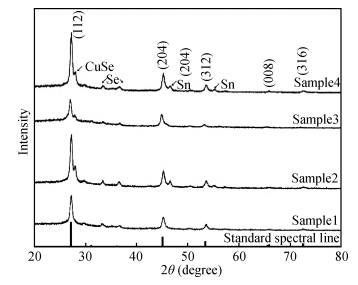
 DownLoad:
DownLoad:
